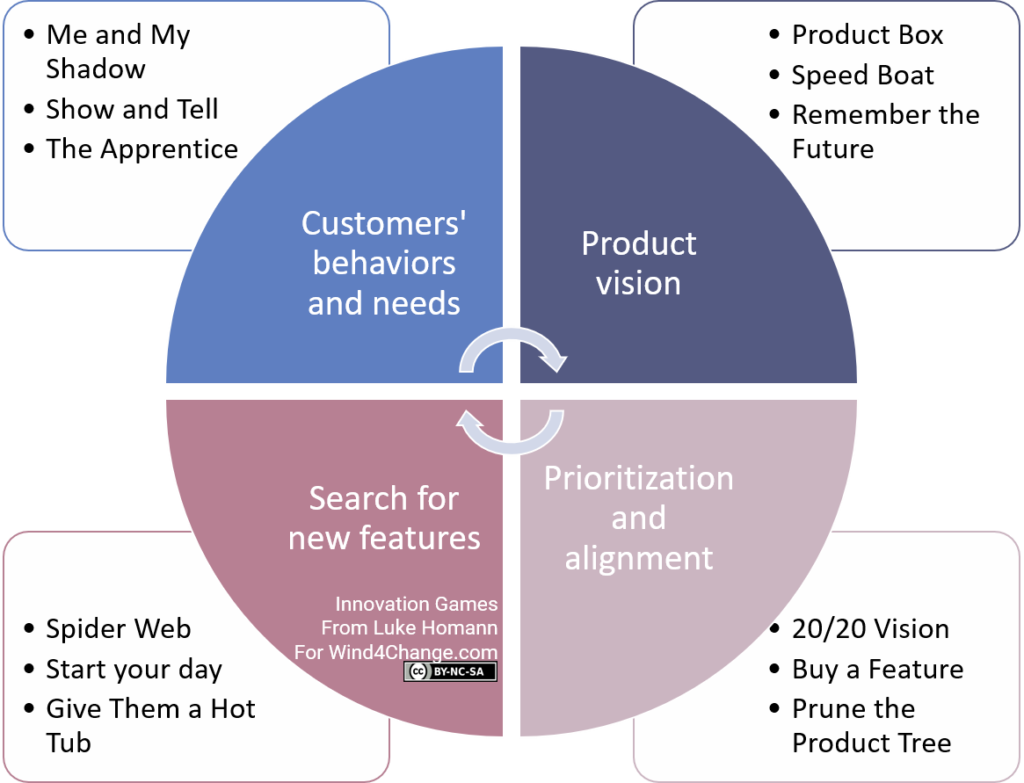Innovation Games are a type of workshops created by Luke Hohmann for market research. To go further, in Innovation Games, customers play serious games to generate understanding about their needs and about how they use the product or the service.
- What are Innovation Games by Luke Hohmann?
- Innovation Games about customers' behaviors and needs by Luke Hohmann
- Innovation Games about product vision by Luke Hohmann
- Innovation Games about prioritization and alignment by Luke Hohmann
- Innovation Games about search for new features by Luke Hohmann
- What’s next? Learn more about Product Development like Lean Startup, Story Mapping, Impact Mapping and Agile
- Do you want to learn more about Innovation Games by Luke Hohmann? Here some valuable references
What are Innovation Games by Luke Hohmann?
What is a market search ?
A market search is a way to get data about the targeted market and customer. It is more than just collecting data and answers about “what you don’t know“. Indeed, it is useful to learn about “what you don’t know that you don’t know“.
Market searches fall in 2 categories
- A primary market search specifically collects data to answer a question about a given market segment.
- On the contrary, a secondary market search reuses data previously collected for other concerns, to try to answer a question.
The typical process of a market research follows the following steps
- Clarify how the data collected will be used and define the right question as a consequence.
- Identify who will answer this question.
- Collect the data.
- Process and analyze the data.
- Take actions based on new insight.
An effective market research is
- Systematic: well-organized with a clear goal and a structured approach.
- Objective: biases are kept to minimum.
- Focused: to answer specific questions as defined at the beginning of the process.
- Actionable: the results should enable relevant actions.
What are Innovation Games by Luke Hohmann?
Innovation Games are a kind of market research to interact, collaborate and run experiments with customers. As a result, you collect qualitative data about customers, learn about their deep needs and create truly innovative products and services.
What makes Innovation Games different?
- Firstly, Innovation Games are fun to conduct and to participate to. Really, this helps using them and getting the involvement of customers.
- Secondly, they foster collaboration and direct feedback between the product team and the customers.
- Thirdly, Innovation Games leverage principles of cognitive psychology and organizational behavior to uncover data difficult to get with that traditional techniques.
- At last, as customers engage all parts of their brain, the data collected is richer and more meaningful.
When to use Innovation Games?
Innovation Games are useful to:
- Conduct market searches to answer specific questions about a market.
- Build deep understanding about customers’ needs and requirements to identify relevant features.
- Identify hidden customers’ needs: learn “what you don’t know that you don’t know”.
- Strengthen the relationship with current key customers.
Guidelines about Innovation Games
12 customers are expected to represent 70% to 75% of market needs, and 30 customers can be expected to represent 90% of market needs.
Duration will also depends on the size of the group:
- Up to 12 people groups make it possible to conduct 2 90-minute Innovation Games in half-day.
- More and you will have only 1 Innovation Game for a half day.

Innovation Games about customers’ behaviors and needs by Luke Hohmann
Me and My Shadow

How to do it
- Follow your customers like a shadow as they use your product or service and observe what they do.
- Ask them from time to time: “Why are you doing that?” and “What are you thinking?“
- Bring with you a camera to take photos of key activities and their context.
- Ask for copies of main artifacts created or used by your customers during the observation about your product or service.
- Additionally, you can invite other customers if they do the same as the person observed. If not, ask them about their alternative way of doing.
Why it works
- Give you deep insight in field use of the product including unexpected ones.
- Enable you to get the rational about the way customers use your product or service and their underlying needs.
Show and Tell

How to do it
- Ask your customers to bring examples of artifacts created or modified with your product or service.
- Then, ask them to tell you why these artifacts matter, then when and how they use them.
Why it works
- Customers are excited about the result that they can create with your product or service and they will tell you about it.
- As a consequence of this sharing from your customers, you will gain new insight about what really matters.
The Apprentice

How to do it
- Propose the development team to use your product or service as real customers.
- Ask them like apprentices to fill a notebook with their experiences, learning and surprises.
- Meet them daily to review their most important learning about the experience.
- At the end of the experiment, have a final review about the learnings and make sure that all is properly documented.
- Optionally, you may invite customers for them to confirm learning and clarify remaining questions.
- At last, identify the gaps, in other words the areas for improvement and opportunities for new features.
Why it works
- Enable the development team to get insight about the product experience by using it like real customers.
- Additional feedback from customers is all the more understood and valuable that the development team has experienced the product.
Innovation Games about product vision by Luke Hohmann
Product Box

How to do it
- Ask your customers to design a box for your product. Surely, this box represents the features and benefits of the product that they want to buy.
Why it works
There are 3 outputs for this workshop: expected features, expected benefits and the unique value proposal of your product:
- Features: in this Innovation Game, you will learn what your customers consider as the most important and desirable features for a given product or service.
- Benefits:
- As they build the marketing package of the product, customers identify more than features but benefits of the product.
- The reinforcement mechanism is the sell exercise especially to other customers that enable to focus on the benefits not the features of the product.
- The slogan of the product is the most important benefit, in other words, the unique value proposal of the product.
Speed Boat

The Innovation Game that we describe here is an enriched version of the one invented by Luke Hohmann. To illustrate, the image of the speed boat is replaced by a sail boat as a more relevant image for this workshop.
How to do it
- Draw an island to make customers think about the expected product or service and make it real.
- Draw a sail boat:
- The sail stands for the opportunities to catch and the strengths.
- The anchors stand for the limitations and the problems to address.
- The emerging rocks stand for the threats to avoid.
- At last, make the team potentially with customers brainstorm on actions to perform to address the problems and take advantage of the opportunities.
Why it works
- Visualization of the island makes it possible for the future to be more real and appealing.
- The visual of boat enables to identify the problems and the opportunities easier.
- At last, the workshop completes with a concrete action plan.
Remember the Future

How to do it
- Suggest your customers to think about the moment in the future after they have been using your product for a while (a month, a quarter or a year depending on your product).
- Make sure to draw a timeline to highlight that your customers remember a future event as if it was the past.
- Ask your customers to write down, as detailed and concrete as possible, what your product will have done to make them happy (or successful or rich or safe or smart depending on the core value proposal of your product).
Why it works
Remembering the future, in other words an event in the past, makes it possible to:
- Firstly, have more details about the result and what the product has done: to put it differently, the definition of the success criteria for the customers.
- Secondly, have more details and a better explanation about how the product achieved the result: that is how that successful outcome happened.
Innovation Games about prioritization and alignment by Luke Hohmann
20/20 Vision

How to do it
- Take a list of between 8 to 20 features to prioritize.
- Write each feature on a card.
- Take each feature one after the other and ask your customers if it is more or less important than the ones on the wall.
Why it works
- Enable to get the relative priority of features.
- Help get insight on what matters and customers’ needs during the prioritization.
Variation
Customers may want to group, split or adjust features so:
- Prepare a design continuum with design alternatives for features.
- Think about possible split or combination of features.
Buy a Feature

How to do it
- Create a list of potential features and provide for each a price. Surely, the price is the development cost. What matter is the relative cost between features.
- Propose a list of features between 15 and 30. Too few features won’t provide interesting discussions. Too many may loose customers and require too much time.
- Customers use the play money you give them to buy features that they want in the next release of your product.
- Give them an amount of money that is low enough for them to focus on priorities and to pool their money for features. Usually, total money distributed is between 1/3 to 2/3 of the total cost of all proposed features.
- Each customer buys a feature explaining why then another customer buy another one and so on.
- When buying a feature, a customer may ask if other customers want to pool especially when money starts missing.
Why it works
- Sharing on why a feature is important during buying or negotiation for money pooling, enables to understand customers’ needs.
- Plus it provides a priority of the features to be delivered. As a result, you can sort them in the order in which they are selected.
Prune the Product Tree

How to do it
Draw a round tree standing for the product:
- Thick limbs represent major areas of functionality within your product or service.
- The inside of the tree stands for short term features.
- The edge of the tree represents the future and long term features.
- A time frame can be added to remind that time goes from the inside (present) to the outside (future).
- Display features on the tree.
- Ask customers to adjust the priorities. In addition, they may drop some features or decrease the priority of a whole functionality area.
Why it works
- Help build an holistic vision of the product.
- Enable to remove features not useful to the customers.
Innovation Games about search for new features by Luke Hohmann
Spider Web

How to do it
- Put the name of your product or service in the center of the visual space.
- Ask your customers to draw other products and services that they consider as related to your product.
- To continue, ask them to tell you when, how, and why these are used.
- At last, ask them to draw lines between the different products and services and highlight important relationships.
Why it works
- The Spider Web game helps you understand how your customers see the relationships between your product and service and other products and services, either competitive or complementary.
- This enables to identify innovative opportunities and capture more revenue.
Variation
Other natures of connection that customers may see:
- Corporate relationships: connections between your company and other companies to identify potential partners then improvement opportunities.
- Location/environmental relationships: connections of your product or service to the environment or location in which it is used.
- Operating relationships: connections of your product or service to other products it uses or requires to accomplish the total task for your customer.
Start your day

How to do it
- Display a large timeline or calendar as a visual to support interactions.
- Ask your customers to describe the daily, weekly, monthly, and yearly moments when they use your product or service. Clearly, include guidelines to make sure they think about all moments such as beginnings and ends of time periods, recurrent events or one-time events.
- As your customers are sharing, be alert on how your product helps or hinders.
Why it works
- Truly, when customers think about one product or service, they usually just think about their last experience. Unfortunately, this creates a biased view with a focus only on some uses or a part of the life cycle of the product.
- By generalizing feedback on all potential moments when the product is used, you will get an holistic feedback about the product with more opportunities for improvement.
Variation
- Locations: ask for your customers to think about other potential locations where they use your product.
- Physical and/or emotional states: ask for your customers to think about their different physical and/or emotional states when they use your product.
Give Them a Hot Tub

How to do it
- Write several features on note cards. Notice that there is one feature per card.
- Include several “outrageous” features, in other words, features that do not make sense at first sight:
- Surely, this is the main challenge of the preparation of this game: “outrageous” features should be extreme enough to provoke cognitive dissonance, but not so extreme as that customers reject the game.
- Actually, it is a good practice to prepare customers before the game by telling them that some of the features will be “funny” or “outrageous”.
- Get the feedback from your customers with 3 possible answers, each time with the explanation of their decision:
- Accept the feature as is without change.
- Reject the feature totally as something they don’t want.
- Transform the feature into a new feature that is relevant for them.
Why it works
An “outrageous” feature generates cognitive dissonance. To put it differently, an “outrageous” feature makes customers somehow uncomfortable. As a result, to get rid of the discomfort, they either reject the feature or adapt it to something more acceptable but still that can be innovative and disruptive.
What’s next? Learn more about Product Development like Lean Startup, Story Mapping, Impact Mapping and Agile
- To learn more about other frameworks supporting Product Development like Lean Startup, Story Mapping and Impact Mapping check my other post.
- In addition, you can review my posts introducing Agile and Agile at Scale.
- At last, learn more about innovation with all my posts about Digital and the disruptive technologies.
Do you want to learn more about Innovation Games by Luke Hohmann? Here some valuable references
- Luke Homann’s book about Innovation Games
- Wikipedia page about Innovation Games
- Luke Hohmann‘s web site
Icons credit:
